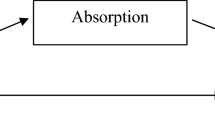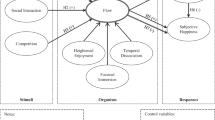Abstract
The article discusses the issue of how to categorize video games—not the medium of video games, but individual video games. As a lead in to this discussion, the article discusses video game specificity and genericity and moves on to genre theory. On the basis of this discussion, a cognitive experientialist genre framework is sketched, which incorporates both general points from genre theory and theories more specific to the video game domain. The framework is illustrated through a brief example. One virtue of the framework is that it offers a way to bridge the gap between game ontology and player experience; a brief conclusion discusses how the breadth of this gap may depend upon player biographies and also outlines how further work may proceed.
Similar content being viewed by others
Notes
The comment about glasses and their contents applies here as well: anything could be seen as yielding unique experiences given that inclination; this is the flipside of the well-known argument that anything can be seen as similar to anything else. This, in turn, means that everything can be seen as yielding typical experiences, but I shall attempt to elaborate and unpack this seemingly vacous claim as we go on.
For a representative expression of the early phase of this debate, see Wardrip-Fruin and Harrigan (2004), and for a later commentary, see Simons (2007). I would like to thank one of the anonymous reviewers for pointing out that these labels can be quite misleading, in that the label “narratology” as used in “narratology vs. ludology” collapses narrativist scholars who prefer to use narrative as what I would call a sensitizing concept (such as Jenkins) and scholars who are inspired by and indebted to formal narratology (such as Aarseth and Eskelinen) – and some of the latter are often taken to be ludologists.
There is of course one domain which is allowed for self-avowed ludologists such as (Juul 2005) and like minded writers such as Salen and Zimmerman (2004): The domain of games. Their position seems to be that video games are or should be seen simply as part of this domain—give or take a couple of provisos. One might thus say that the strict ludologist that I am conjuring forth is really a strict video-ludologist.
One of the most immediately visible ways to achieve a particular framing in the cultural industries is the extensive use of paratext(s), where products such as games are explicitly furnished with genre labels—but collective understandings obviously also depend upon previous experiences of the works themselves, which form the basis of the myriad potential relations between individual works that genres offer to the producers and consumers, without these being explicated by paratexts.
I will forego any discussion of whether video games are, in fact, fictional or not; I use the terms representation and simulation throughout.
For an example of how multiple elements can be tracked in evolution of a particular game genre, see Arsenault (2009) on the first-person shooter.
Another approach to classification could be mentioned here, namely that exemplified by Elverdam and Aarseth (2007) game classification scheme. Such classification schemes should, I think, not be seen as fundamentally antithetical to or incompatible with genre theories, since both are at root involved in classification. One simple argument for classification schemes is that they allow for categorizing without making larger claims about genre and may be used to pick out categories which may fall outside of traditional genre concerns while still being useful. Since classifications schemes are often built with mutually exclusive subcategories, there is a tendency towards the aims of classical genre theory—either X is A or B, never both. It might be possible to build a formal faceted classification scheme from a synthesis of the available resources outlined above and tie this to genre concerns, but this would go way beyond this paper. The primary argument is still that games can be and are routinely classified as exhibiting typicality by people interacting with games and, in addition, that games may be said to utilize a vast collection of generic resources and in doing so instantiate similarities on many different levels. The argument is further that all of these similarities may be seen as the generic scaffolding of the potentially generic experience of playing such games.
Or has no experience of the relevant domains outside of games, for instance, science fiction or fantasy literature or war movies.
References
Aarseth, E. J. (2003). Playing research: Methodological approaches to game analysis. Paper presented at the DAC 2003, Melbourne.
Aarseth, E. J. (2005). From Hunt the Wumpus to EverQuest: Introduction to Quest Theory. Sanda, Japan: In Proceedings, Entertainment Computing - ICEC 2005: 4th International Conference.
Altman, R. (1998). Reusable packaging: Generic products and the recycling process. In N. Browne (Ed.), Refiguring American Film Genres: Theory and History. Berkeley: University of California Press.
Altman, R. (1999). Film/Genre. London: BFI.
Arsenault, D. (2009). Video game genre, evolution and innovation. Eludamos. Journal for Computer Game Culture, 3(2).
Austin, J. L. (1961). Philosophical Papers. Oxford: Oxford University Press.
Bethesda Game Studios (2008). Fallout 3. PC. Bethesda Softworks.
Bethesda Softworks (1994–2013). The Elder Scrolls (series). PC. Bethesda Softworks.
Blizzard Entertainment (2004). World of Warcraft. PC. Blizzard Entertainment.
Bowker, G. C., & Star, S. L. (1999). Sorting Things Out. Classification and Its Consequences. Cambridge, MA: MIT Press.
Cawelti, J. G. (2004). Mystery, Violence, and Popular Culture. Madison, WI: University of Wiscons in Press.
Eco, U. (1985). Innovation and repetition: Between modern and post-modern aesthetics. Daedalus, 114(4), 161–184.
Egenfeldt-Nielsen, S., Smith, J. H., & Tosca, S. P. (2008). Understanding Video Games. The Essential Introduction. New York: Routledge.
Elverdam, C., & Aarseth, E. (2007). Game classification and game design. Games and Culture, 2(1), 3–22.
Epic Games. (2006). Gears of war. Xbox 360.Microsoft Game Studios.
Frow, J. (2006). Genre (the New Critical Idiom). London: Routledge.
Fullerton, T., Swain, C., & Hoffmann, S. S. (2008). Game Design Workshop. A Playcentric Approach to Creating Innovative Games (2nd ed.). Burlington, MA: Morgan Kaufmann.
Garfinkel, H. (1967). Studies in Ethnomethodology. Englewood Cliffs, NJ: Prentice-Hall.
Gregersen, A. L. (2011). Genre, technology and embodied interaction: The evolution of digital game genres and motion gaming. MedieKultur. Journal of media and communication research, 27(51).
Gregersen, A. L., & Grodal, T. (2009). Embodiment and Interface. In B. Perron, & M. J. P. Wolf (Eds.), The Video Game Theory Reader 2. London: Routledge.
Heeter, C. (1989). Implications of new interactive technologies for conceptualizing communications. In J. L. Salvaggio & J. Bryant (Eds.), Media Use in the Information Age: Emerging Patterns of Adoption and Consumer Use (pp. 217–236). Hillsdale, NJ: Lawrence Erlbaum Associates.
Heeter, C. (2000). Interactivity in the context of designed experiences. Journal of Interactive Advertising, 1(1).
Hesmondhalgh, D. (2007). The Cultural Industries (2nd ed.). London: Sage.
Hunicke, R., LeBlanc, M., & Zubek, R.(2004). MDA: A formal approach to game design and game research. In Proceedings of the AAAI Workshop on Challenges in Game AI, (pp. 04–04).
Infinity Ward/Treyarch (2003–2013). Call of Duty (series). PC. Activision.
Irrational Games (2007). Bioshock. PC. 2K Games.
Jensen, J. F. (1999). 'Interactivity'—Tracking a new concept in media and communication studies. In P. A. Mayer (Ed.), Computer Media and Communication (pp. 160–187). Oxford: Oxford University Press.
Juul, J. (2005). Half-Real: Video Games Between Real Rules and Fictional Worlds. Cambridge, MA: MIT Press.
Kiousis, S. (2002). Interactivity: A concept explication. New Media Society, 4(3), 355–383.
Lakoff, G. (1987). Women, Fire, and Dangerous Things. What Categories Reveal about the Mind. Chicago: University of Chicago Press.
Laurel, B. (1993). Computers as theatre. Reading, Mass.: Addison-Wesley.
Miller, C. R. (1984). Genre as social action. The Quarterly Journal of Speech, 70(2), 151–167.
Neale, S. (2000). Genre and Hollywood. London: Routledge.
Nintendo, (2007). Super Mario Galaxy. Wii. Nintendo.
Nintendo, (2008). Mario Kart Wii. Wii. Nintendo.
Pajitnov, A. (1984). Tetris.
PopCap Games (2001). Bejeweled. PC. PopCap Games.
Rockstar North (2008). Grand Theft Auto IV. Xbox 360. Rockstar Games.
Rockstar San Diego (2010). Red Dead Redemption. Xbox 360. Rockstar Games.
Rocksteady Studios (2009). Batman:Arkham Asylum. PC. Eidos Interactive Ltd.
Salen, K., & Zimmerman, E. (2004). Rules of Play. Game Design Fundamentals. Cambridge, MA: MIT Press.
Schatz, T. (1981). Hollywood Genres. Formulas, Filmmaking, and the Studio System. New York: Random House.
Schutz, A. (1962). Collected papers I. The Problem of Social Reality. The Hague, NL: Martinus Nijhoff.
Simons, J. (2007). Narrative, games, and theory. Game Studies, 7(1).
Steuer, J. (1995). Defining virtual reality: Dimensions determining telepresence. In F. Biocca & M. R. Levy (Eds.), Communication in the Age of Virtual Reality (pp. 33–56). Hillsdale, NJ: Lawrence Erlbaum Associates.
Valve Corporation (1998). Half Life. PC. Sierra Entertainment.
Wardrip-Fruin, N., & Harrigan, P. (Eds.). (2004). First Person. New Media as Story, Performance, and Game. Cambridge, MA: MIT Press.
Wittgenstein, L. (1958). Philosophical Investigations. 2. ed. (G. E. M. Anscombe, Trans.). Oxford: Basil Blackwell.
Wolf, M. J. P. (Ed.). (2001). The Medium of the Video Game. Austin: University of Texas Press.
Yates, J., & Orlikowski, W. J. (1992). Genres of organizational communication: A structurational approach to studying communication and media. The Academy of Management Review, 17(2), 299–326.
Author information
Authors and Affiliations
Corresponding author
Rights and permissions
About this article
Cite this article
Gregersen, A. Generic Structures, Generic Experiences: A Cognitive Experientialist Approach to Video Game Analysis. Philos. Technol. 27, 159–175 (2014). https://doi.org/10.1007/s13347-013-0125-8
Received:
Accepted:
Published:
Issue Date:
DOI: https://doi.org/10.1007/s13347-013-0125-8




